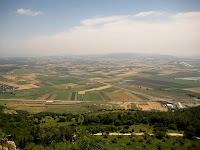














Photos: Imat's twins and friend; Imat and Lew; Daliat-al Carmel market; view from Carmelite monastery; views from Haifa, Ba'hai Gardens
We spent our second night in the north in the Druze village of Daliat-al-Carmel enjoying the incomparable hospitality of our host Imat Halaby, a master stonemason who has transformed the lower level and garden of his home into a fairy-tale zimmer (bed and breakfast). It’s worth a look at the website to see the remarkable stone-work in the bedroom/bath suite and the living areas. While I knew about the Fauzi Azar Inn from Lonely Planet and other sources, I stumbled on Imat’s place in a post on a Trip Advisor Middle East webchat. A truly lucky find! From the moment he met us in the main intersection of town to guide us with his car to his home, until the moment he handed Lew and Norman their own set of prayer beads (he fingers his while he talks) as a parting gift, we were swept into the orbit of his enthusiastic and generous nature. Imat, a well-educated and worldly man in his 50’s, regaled us with stories of his family, travels, and Druze history and customs. Drinking tea served to us on the patio by Nawal, Imat’s attractive wife, we learned about his immediate family, including Hatim, his 21-year old son who is studying at Technion University, his 18-year old teenage twin girls Imab and Rabab, two brothers (one a lawyer) who live in houses next door, and his very active parents who still tend their olive orchard (father) and prepare homemade cherry jam (mother). The larger clan of 7,000 constitutes almost half of the villages’ 15,000 residents, a tight-knit community that discourages intermarriage with non-Druze (violators are shunned and relatives are not supposed to associate with them). Imat’s views represent a mix of modernity and tradition. He strongly encourages education, driving his girls to a centralized elite Druze high school in another town about an hour away; he is highly entrepreneurial and sophisticated in marketing his work; he has traveled widely to Europe and elsewhere. Yet, he keeps a close watch on his children and retains Druze customs and beliefs. The Druze, who are loyal citizens of Israel and serve in the IDF, differ from Muslims from whom they broke away hundreds of years ago. According to Druze custom, their religious leaders are the only ones allowed to read the sacred text (Yitro, Moses’ father-in-law is considered the central prophet) and interpret it for the lay population. Prayer services are held twice weekly in unmarked temples (historically, to avoid persecution by Muslims), in contrast to the five times a day Islamic prayer ritual. The Druze believe that all existing persons are reincarnations of past souls, a belief Imat illustrated by sharing some complicated stories of coincidences experienced by relations and friends. When I asked Imat to tell me about some holiday customs or home observances (like lighting Shabbat candles) he couldn’t really think of anything. I’m not sure if he understood my question or if there really aren’t many other than frequent family gatherings, engagement parties and weddings. Even death is not ritualized much—no special burial customs or markers on gravesites—due to the belief in reincarnation.
When we inquired about a good place for dinner, Imat personally led us in his car to a nearby restaurant and ordered a sumptuous meal for us—chicken and rice with cinnamon and spices, chicken and onions on flat bread, tabbouli salad, rocket salad, hummos, olives, pita with zatar, and other small salads/relishes. I must add that the freshness of the tabbouli and rocket salads in Daliat-al-Carmel and in Nazareth is something to write home about. When we returned to the zimmer, Imat appeared downstairs carrying a huge bowl of fruit --pommelos, oranges, apples, offering us pieces as he expertly peeled and cut them, and engaging us in frank and friendly discussion about the history and current status of relations among Arabs, Palestinians, Druze and Jews. The next morning he brought down a huge breakfast spread prepared by Nawal and again remained to share stories about his travels in Europe. My attention was equally riveted on Imat and his mother’s cherry jam. As we said our goodbyes we felt as if we were leaving an old friend whom we hoped to see again soon.
At Imat’s suggestion we set out to visit the nearby Carmelite monastery before leaving town. On the way, however, we just happened to pass the outdoor Saturday market, a very popular place for locals and visitors from Haifa. Of course we had to stop to admire the colorful people, fabulous food and everything else you can think of from soup to nuts to underwear to barbeque grills. When we finally reached the monastery we were not disappointed. The view from the roof is spectacular, stretching from the sea to Mt. Meron (Israel’s highest peak) and down the length of the Jezreel Valley. It was a beautiful day as we drove through the Druze village of Isafiya and on to Haifa, capping our journey north with a visit to the overlook of the perfectly manicured Ba’hai gardens and lunch on the shaded patio of Fatoosh in the German Colony. Then, following the coastline, we admired the sparkling blues of the sea as we drove back to Tel Aviv.
No comments:
Post a Comment